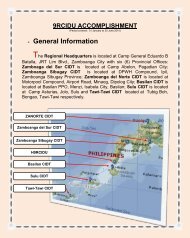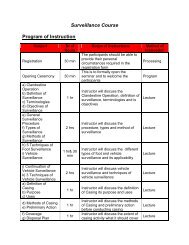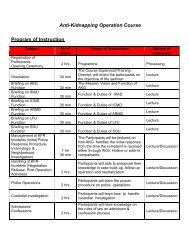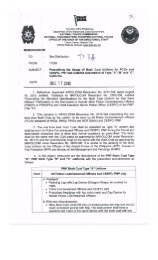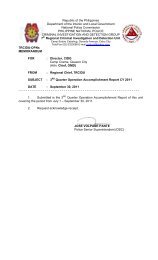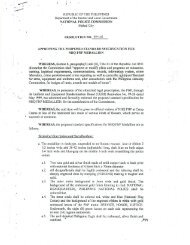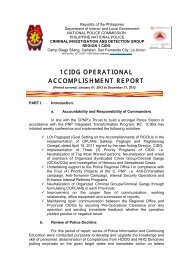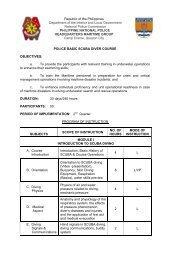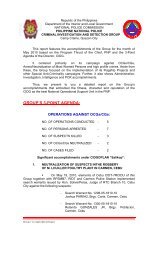Barangay Peacekeeping Operation - Philippine National Police
Barangay Peacekeeping Operation - Philippine National Police
Barangay Peacekeeping Operation - Philippine National Police
You also want an ePaper? Increase the reach of your titles
YUMPU automatically turns print PDFs into web optimized ePapers that Google loves.
CHAPTER I<br />
BARANGAY PEACEKEEPING OPERATION<br />
(A CONCEPT)<br />
A. INTRODUCTION<br />
When the first Spaniards arrived in the 16th century, they found the Filipinos having a<br />
civilization of their own and living in well-organized independent villages called barangays. The<br />
name barangay originated from balangay, a Malay word meaning “sailboat”.<br />
Historically, a barangay is a relatively small community of around 50 to 100 families. Most<br />
villages had only thirty to one hundred houses and the population varied from one hundred to<br />
five hundred persons.<br />
Upon the arrival of the Spaniards, several ancient barangays were combined to form towns.<br />
Every barangay within a town was headed by the cabeza de barangay (barangay chief), who<br />
formed part of the elite ruling class of the municipalities of Spanish <strong>Philippine</strong>s. The post was at<br />
first inherited from the first datus who became cabezas de barangay, but then was made into<br />
an elected one after the Spanish regime. The primary job of the cabeza de barangay was to<br />
collect taxes, or tribute, from the residents. The datu was primarily in charge in the maintenance<br />
of peace and order within the balangay.<br />
As history shows, the <strong>Philippine</strong>s had its own unique way of community policing. While we<br />
adopted in the past various community policing systems, such as Koban of Japan and Singapore<br />
<strong>Police</strong> Force, nevertheless, we have to resort to our homegrown policing system anchored on the<br />
community partnership called bayanihan.<br />
Bayanihan answers the need for the whole neighborhood to get involved in policing and<br />
law enforcement. The community relies upon the police to “serve and protect” and the police,<br />
in return, rely upon community support and cooperation in order to be effective.<br />
In the past, various anti-criminality strategies and concepts were adopted by the PNP in its<br />
effort to curb criminality and maintain peace and order. However, most of the concepts were<br />
found to be unsustainable as these were just revised versions of crime prevention concepts from<br />
other countries and were not suitable to the existing criminality situation in the <strong>Philippine</strong>s.<br />
It is along this line that a peacekeeping concept responsive to the unique peace and order<br />
condition in the <strong>Philippine</strong>s needed to be crafted. The concept basically calls for PNP members<br />
to lead in the fight against all forms of criminality (including insurgency) distinct to their areas of<br />
responsibility, utilizing active citizen involvement and community empowerment.<br />
This is also in response to the CPP-NPA <strong>Barangay</strong> Module being implemented by left-leaning<br />
13



